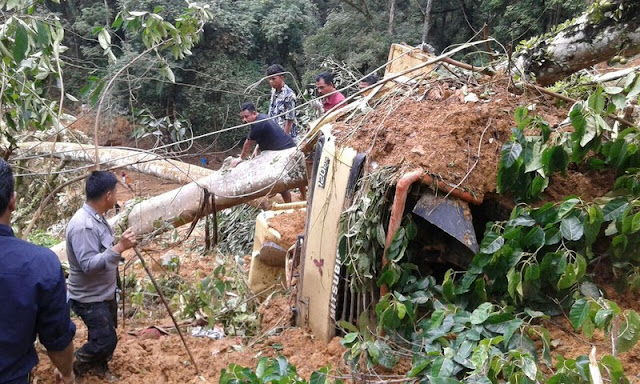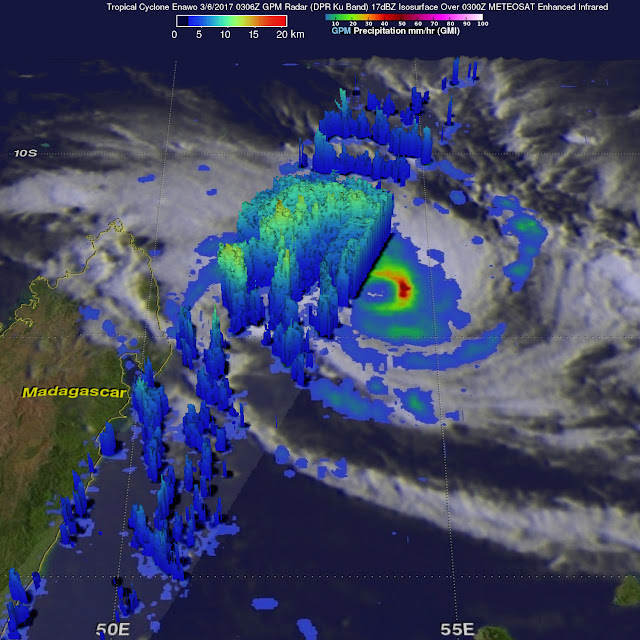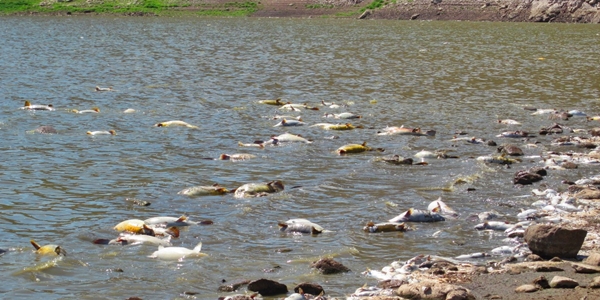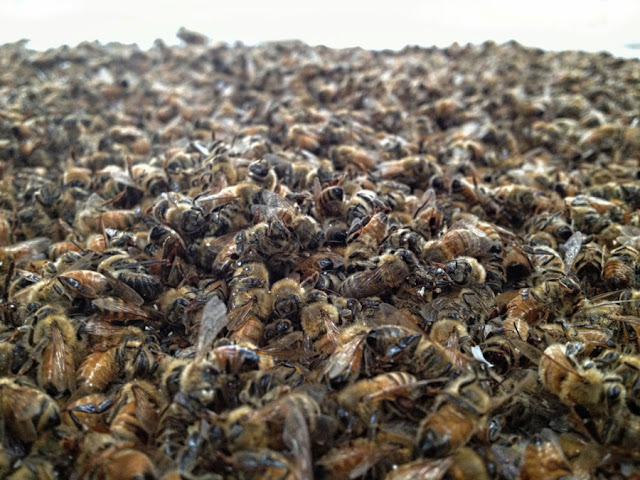- Indonesia – 6 Killed in Floods and Landslides in West Sumatra: Thousands of residents isolated by flood waters and landslides
- Wall of water and sustained wind speeds of 195km/h hits northern Madagascar as "intense" tropical cyclone Enawo makes landfal: 220 mm (8.7 inches) rain per hour
- Another algae bloom thought to be responsible for the deaths of thousands of threadfin shad at Apache Lake Arizona
- Mass Death and Extinction of the Bees! Could be catastrophic to mankind within four years as many species have dropped by up to 90%
| Indonesia – 6 Killed in Floods and Landslides in West Sumatra: Thousands of residents isolated by flood waters and landslides Posted: 07 Mar 2017 01:15 AM PST Photo floodlist.com At least 6 people have been killed, 2 seriously injured and thousands displaced due to floods and landslides in Indonesia‘s West Sumatra province. According to the country’s disaster agency, four of the victims died in landslides and two as a result of flooding. Heavy downpours from 03 March 2017 affected areas of Limapuluh Koto Regency, resulting in several rivers overflowing and as many as 13 landslides. Several vehicles were buried in the landslides and disaster officials have been searching affected areas. As of 04 March, 4 bodies had been found in the buried vehicles. Thousands of residents in Lima Puluh Kota Regency in West Sumatra have been isolated by flood waters and landslides that hit the region on Friday last week. The connecting roads to the regency had been cut off. "Thousands of our residents are still isolated because of rough terrain," Lima Puluh Kota Regent Irfendi Arbi said on Monday, March 6, 2017. Data from the National Disaster Mitigation Agency (BNPB) Lima Puluh Kota Regent show that the disasters have isolated 2,272 residents of Nagari Galugua, some 3,251 residents of Nagari Koto Lamo and 350 residents of Neran Nagari Maek. "The BNPB and Basarnas [the National Search and Rescue Agency] have deployed bell UH-1 helicopters to comb flooding and landslide locations in the sub-districts of Kapur IX and Pangakalan Koto Baru," he said. Irfendi said that logistics distribution in isolated areas will be carried out by helicopters. Meanwhile, search and rescue teams will open access roads to isolated areas by cleaning landslide material. Lima Puluh Kota Police chief Adj. Sr. Comr. Bagus Suropratomo said that search and rescue teams are still searching for flood and landslide victims. Reports earlier said that six persons were killed by the floods and landslides in the region. Home Page The Wire |
| Wall of water and sustained wind speeds of 195km/h hits northern Madagascar as "intense" tropical cyclone Enawo makes landfal: 220 mm (8.7 inches) rain per hour Posted: 07 Mar 2017 01:07 AM PST On Mar. 6, GPM rainfall data found rain falling at a rate of over 220 mm (8.7 inches) per hour in intense downpours. Many of these storms were reaching altitudes above 16 km (9.9 miles). Credits: NASA/JAXA, Hal Pierce
A direct strike on northeastern Madagascar would also lead to a life-threatening storm surge near and to the south of where Enawo makes landfall. Water funneling into Helodrano Antongila Bay could especially put lives and property in danger in Maroantsetra. Tropical cyclone Enawo is bearing down on Madagascar and flooding was already being reported in the north eastern part of the country on Tuesday. Enawo was 70km from the coastal town of Sambava earlier in the day and was expected to make landfall at 10am. The storm is now classified as an "intense" tropical cyclone with sustained wind speeds of 195km/h and downpours in excess of 100mm per day. Madagascar Weather Service head of meteorology for the Antananarivo region' Anzela Ramarosadratana' predicted flooding in the island's capital city on Wednesday. "There is a red warning for flooding in the north of Madagascar' and there is a flood in north eastern part of Madagascar now'" Ramarosadratana told TMG Digital. "The government will take the responsibility to help the population in the northern part of the country. We estimate that the cyclone will reach the south of Madagascar by the 10th of March. We think that the whole island will be affected by the cyclone." Satellite images show another storm brewing behind Enawo' but the Madagascar Weather Service is keeping an eye on it and does not expect it to reach the island. "We can see on the satellite image that there is another system behind it' but it is not yet a tropical cyclone. It is more south from Madagascar' it is very far and we anticipate that it will not reach Madagascar'" Ramarosadratana said. Three successive years of failed rains have left the island nation wrestling with crop failure and a chronic lack of food and clean drinking water, with agencies warning last month that nearly 850,000 people are experiencing “alarming” hunger levels. “Three hundred and thirty thousand are on the verge of a food security catastrophe, next step being famine,” said Dominique Burgeon, director of emergencies and rehabilitation at the UN’s Food and Agriculture Organisation (FAO). In this 3-D Flyby animation of GPM rainfall data, rain was falling at a rate of over 220 mm (8.7 inches) per hour in intense downpours. Many of these storms were reaching altitudes above 16 km (9.9 miles). Credit: NASA/JAXA, Hal Pierce Home Page The Wire |
| Another algae bloom thought to be responsible for the deaths of thousands of threadfin shad at Apache Lake Arizona Posted: 06 Mar 2017 11:49 PM PST Photo Save the Water Another algae bloom is thought to be responsible for the deaths of thousands of threadfin shad at Apache Lake in the Tonto National Forest, Arizona The Arizona Game and Fish Department have investigated the death of thousands of fish and determined the die-off was caused by a golden alga bloom largely restricted to the riverine portion of Apache below Roosevelt Lake. According to The Arizona Game and Fish Department “Golden algae thrives on elevated salinity associated with drought conditions,” said Marc Dahlberg, Water Quality Manager at AZGFD. “Therefore, recent heavy rains will hopefully knock down salinity levels and help control golden alga blooms.” At this point, AZGFD believes the fish kill has been restricted to threadfin shad and a few gizzard shad, both of which are highly sensitive to the toxin produced by golden alga. The last such fish die-off in this region occurred in 2007, also in upper Apache Lake. However, there were significant fish kills caused by golden alga in Saguaro, Canyon and Apache during the early-to-mid 2000s that affected all fish species. Home Page The Wire |
| Mass Death and Extinction of the Bees! Could be catastrophic to mankind within four years as many species have dropped by up to 90% Posted: 06 Mar 2017 07:12 AM PST Photo The Huffington Post In just three years’ time the World will have lost two-thirds of all wild animals. This amazing statistic from The Living Planet Index goes on: The number of wild animals living on Earth is set to fall by two-thirds by 2020, according to a new report, part of a mass extinction that is destroying the natural world upon which humanity depends. However what I would like to focus on today is the plight of bees of which Albert Einstein was credited with this quote; “If the bee disappeared off the face of the Earth, man would only have our years left to live!”(There is no proof he actually said this.) Perhaps the biggest foreboding danger of all facing humans is the loss of the global honeybee population. The consequence of a dying bee population impacts man at the highest levels on our food chain, posing an enormously grave threat to human survival. Since no other single animal species plays a more significant role in producing the fruits and vegetables that we humans commonly take for granted yet require near daily to stay alive, the greatest modern scientist Albert Einstein once prophetically remarked, “Mankind will not survive the honeybees’ disappearance for more than five years.” Since 2006 beekeepers have been noticing their honeybee populations have been dying off at increasingly rapid rates. Subsequently researchers have been scrambling to come up with an accurate explanation and an effective strategy to save the bees and in turn save us Homo sapiens from extinction. Extreme weather or climate change will be playing a significant role in the deaths of bees with droughts and extreme cold affecting the bees. A new government study blames a combination of factors for the mysterious and dramatic loss of honeybees, including increased use of pesticides especially in the US, shrinking habitats, multiple viruses, poor nutrition and genetics, and even cell phone towers. However, according to last year’s joint EPA-USDA study, the biggest cause is the parasite called the Varroa destructor, a type of mite found to be highly resistant to the insecticides that US beekeepers have used in attempts to control the mites from inside the beehives. Moreover, new virus species have been found in the US and several of these have been associated with Colony Collapse Disorder. In a vicious cycle, since 1987 when the Varroa mite was first discovered in the US, Monsanto, Dow, Bayer and other large chemical manufacturers aggressively glommed onto the bee industry selling genetically modified insecticides and herbicides as the quick and easy fix to remedy the parasitic invasion, only to weaken the bees’ natural genetic defenses to fight off the parasite. In an article from the Guardian earlier this month, Monsanto’s contribution to the vanishing bee population is detailed. From genetically altered corn, Monsanto produced an insecticide called Bacillus thuringiensis (Bt), which once ingested by bees, Bt binds to receptors within the bee’s stomach lining that keeps the bee from eating. Of course this weakens the bee, causing the breakdown of the inner stomach wall, which in turn makes the bee susceptible to spores and bacteria. To further compound the problem, for years the lobbying power of the chemical giant denied causing damage to the bee’s internal immune capacity for resistance to parasites, which of course only continued to kill off the bee population worldwide. Thus, continued chemical use, especially in America, only exacerbates this growing problem. Also on Greenpeace’s Save the Bees page, a type of insecticide called neonicotinoids is known to cause acute and chronic poisoning not just of one bee, but the entire colony. Bees take the contaminated nectar and pollen spread through the plant’s DNA back to the hive, creating a highly toxic living environment for all the bees. Toxicity builds up destroying the Central Nervous System, causing further disorientation and bees ultimately can neither fly nor make it back to the nest. Meanwhile, unlike the US, in Europe and Australia where the health of insects and humans is deemed more important than corporate profit, laws banning insecticide use have been passed, which in large part has largely saved the bee populations from being so decimated there. More on Death and Extinction of the Bees here Below is a small list of Bee deaths around the world so far this year In February, 2017, more than 10 million bees died in an apiary in the rural area of Porto Ferreira Brazil in less than a week. According to the owner, all the work of almost four decades was lost in the 136 hives due to agrochemicals of sugarcane. In February 2017; Millions of bees die in massive pesticide poisoning in the Region of Murcia, Spain. Greenpeace and beekeepers report that the pollution event occurred when insecticides were applied to fruit trees. In February, 2017; Thousands of dead and dying bees are washing up on a popular beach in Southern Florida. Naples beach goers had to watch where they stepped Tuesday after some people say they have been stung just along the shoreline January 2017; 10 Million bees dead 'due to pesticides' in Porto Ferreira, Brazil. Mass bee die offs Home Page The Wire |








» utube MM&C 4/26/24 Iraqi Dinar - US Treasury Exchange Rates- Focus - Banking Partnerships - Rate C
» Parliamentary efforts to transform Iraq into a global market for transferring Internet capacities
» A parliamentary committee that enriches the political forces: Stop plundering Iraq’s wealth and work
» Politician: Salem Al-Issawi is the most likely to assume the presidency of Parliament
» The price of the dollar is close to 145 thousand dinars؛ how much is $100 worth of transactions؟
» Al-Sudani: The world today is witnessing crises whose impact has been reflected in the global econo
» The Federal Court responds to an inquiry by Al-Sudani regarding the powers of the provincial council
» Among them are the Iraqis... a list of the most sought-after immigrants to America
» An expert talks about the "biggest barrier" and the positives of merging Iraqi and Arab banks
» The House of Representatives adjourns its session
» Parliamentary demands to expedite the legislation of the Eid al-Ghadir holiday law (documents)
» Parliament adds the paragraph “Electing the Speaker of the House of Representatives” to its agenda
» Alsumaria publishes the text of the law against prostitution and homosexuality
» A parliamentarian reveals the reason for the failure of the Speaker of Parliament to pass during tod
» Al-Sudani: The government has launched many strategies and initiatives that will improve the reality
» International Business: Iraq has made progress in supporting businesses through investment and priva
» Association of Banks: Iraq is witnessing great development in the transition to electronic governmen
» The House of Representatives votes to add an item to its agenda (election of the Speaker of the Hous
» Parliamentary integrity: Combating corruption requires parliamentary legislation
» Al-Karaawi: America is trying to restrict Iraq
» The State of Law coalition moves to form the local government in Diyala
» The Sudanese and his battle against corruption.. Where is the fault with the government or with the
» Prime Minister's Advisor: We will see the dollar fall on the black market soon
» The Sunni blocs are resolute. The presidency of the Council is ours, away from Al-Halbousi
» Al-Sudani discusses with a workers’ organization his government’s steps in this field
» Parliament holds its session in the presence of 170 deputies
» In the presence of Nechirvan Barzani and Al-Sudani... the State Administration Coalition holds an “i
» The UAE company ADNOC resorts to Iraqi oil. Find out the reasons
» The Iraqi Parliament votes to add an item to elect a president to its agenda
» The Federal Court responds to an inquiry by Al-Sudani regarding the powers of the provincial council
» Al-Sudani: It is necessary to attract women to work as a productive energy that cannot be disrupted
» Zebari regarding targeting the Kormor field: a systematic attack on the economy of Kurdistan
» Saudi Arabia tops, and this is Iraq's rank... a list of major suppliers of crude oil to South Korea
» With a value of 125 million dollars.. Iraq is at the forefront of countries importing Iranian textil
» More than a billion dollars in sales from the Iraqi Central Bank within a week
» Al-Sudani stresses the need for the expertise of the International Labor Organization to legislate a
» Including the return of 21 wanted persons.. The Iraq Money Recovery Fund counts its achievements in
» The path to development is the criterion between true patriotism and political clowning.
» The file of the Presidency of Parliament is on the state administration table... this evening
» Director General of the International Labor Organization: Many challenges in the world of work and t
» Al-Sudani: The world is witnessing crises that reflect negatively on the Arab and international peop
» Prime Minister: Our government has provided great support for the success of the activities, program
» Al-Asadi: Iraq places the social protection file among its priorities
» Al-Sudani: Iraq is one of the first countries in the region to join the International Labor Organiza
» In the presence of Al-Sudani and Barzani, the State Administration Coalition holds an “important” me
» Appreciating the presence of Al-Sudani... Director General of the Arab Labor Organization: Here from
» Prime Minister: Our government has provided great support for the success of the activities, program
» Al-Sudani: The world is witnessing crises that reflect negatively on the Arab and international peop
» The Parliamentary Development Institute organizes a workshop on the political role of the representa
» With Arab and international participation. Tomorrow will be the start of the Fourth Baghdad Internat
» OPEC Secretary General: The end of oil is not on the horizon
» Closing a number of unlicensed offices and companies south of Baghdad
» Repercussions of the bombing...intensive government movements to resume work in the “Kormor” field
» In the presence of Al-Sudani...the opening of the Arab Labor Conference in its 50th session in Baghd
» Al-Sudani: We are working on drawing future visions regarding the “green and digital” economic secto
» Barzani after the Kormor attack: We are ready to coordinate with Baghdad to put an end to these atta
» Al-Sudani directs the formation of an investigative committee into the circumstances of the Kormo fi
» Bismayah is confused about the new electronic portal.. What about the landlord and the subcontracts?
» Kurdistan Government: Loss of 2,500 megawatts of electricity due to targeting the Kormor field
» Crisis in Kurdistan: 12-hour daily power outage and complaints of “confusion”
» The Supreme Anti-Corruption Commission demands Nineveh for the contracts concluded by “Najm Al-Jubou
» Al-Khanjar, Al-Samarrai, and Abu Mazen are hosted by Shaalan Al-Karim to discuss accelerating the se
» Iraq asks the countries of the world to respond to its requests to extradite wanted persons: We have
» “It is coming soon.” The Sudanese advisor sets the date for the referral of the Baghdad metro and th
» Al-Mubarqa: Iraq reserves its full right to respond to the Australian behavior
» Dollar exchange rates on Iraqi stock exchanges... recorded a decline, and this is the list
» Mr. Al-Sadr supports the position of American university students
» Iraqis are ranked 7th in the Arab world on the list of those most seeking immigration to America. He
» Soon.. 3 new hospitals will open in Baghdad
» Sponsored by Al-Sudani...the opening of the Arab Labor Conference in its fiftieth session in Baghdad
» Al-Shammari chairs a meeting at the controlling headquarters to review the results of the security o
» Arab Labor Organization: We commend Iraq's interest in the Arab Labor Conference
» Al-Sudani: The development road project will provide many job opportunities
» Sudanese advisor criticizes Kuwaiti analyzes regarding the development road project
» Al-Mandalawi stresses the need to strengthen economic and trade cooperation between Iraq and Poland
» Power maneuvers: America provides defensive weapons to Kurdistan in exchange for withholding from Ba
» Kuwait is drilling an oil well near Umm Qasr, towards Iraqi territory
» In the document... the first Iraqi ministry identifies the obstacles to changing the new official wo
» Italian Institute: Iraq is stuck in its own crises, including Baghdad’s efforts to undermine the “au
» The head of the Integrity Commission announces the holding of an international Interpol conference i
» Planning: Iraqi companies are not efficient in conducting the population census
» MM&C 4/25/24 National Bank of Iraq goes live with Temenos core banking and payments
» A banking official indicates a "danger" to Iraq by depriving more than half of its banks of dollars
» With the participation of the Association of Private Banks, investment opportunities are on the tabl
» Within a month... an Iranian border crossing recorded a noticeable increase in exports of goods to I
» The Association of Private Banks appreciates the efforts of the government and the Central Bank to c
» Al-Maliki's coalition presents a third candidate for the position of governor of Diyala
» Arab gathering: The Kirkuk problem is getting complicated and the Sudanese must intervene
» Next week.. a Kurdish delegation will visit Baghdad to meet with the Minister of Finance
» Under the pretext of salaries... Al-Party refrains from handing over port revenues to Baghdad
» Association of Banks: For the first time, we are witnessing a clear targeting of depriving half of t
» Parliament does not know the reason for the delay in sending the 2024 budget schedules: Voting takes
» Applicants for the 2024 Hajj are demanding that the Central Bank secure the dollar for them through
» Governmental and private banks will showcase their services tomorrow during Financial Inclusion Week
» Iraq's oil exports rise despite OPEC+ cuts
» A study explodes a "surprise"... Iraq is among the countries that export oil to "Israel": How is the
» Al-Araji emphasizes working to strengthen national identity
» Al-Sudani visits Saudi Arabia to participate in the World Economic Forum in Riyadh